Gerhard “Gerd” Barkhorn (Gerd being short form for Gerhard) was the second most successful fighter ace of all time after fellow Luftwaffe pilot Erich Hartmann. Other than Hartmann, Barkhorn is the only fighter ace to ever exceed 300 claimed victories. Barkhorn flew his first combat missions in May 1940, during the Battle of France and then the Battle of Britain without shooting down any aircraft. His first victory came in July 1941 and his total rose steadily against Soviet opposition. In March 1944 he was awarded the second highest decoration in the ‘Wehrmacht’ when he received the Knight’s Cross of the Iron Cross with Oak Leaves and Swords for 250 aerial victories. Despite being the second-highest scoring pilot in aviation history, Barkhorn was not awarded the Diamonds to his Knight’s Cross with Oak Leaves and Swords after achieving his 300th victory on 5 January 1945.

Barkhorn flew 1,104 combat sorties and was credited with 301 victories on the Eastern Front against the Soviet Red Air Force piloting the Messerschmitt Bf 109 and Focke-Wulf Fw 190D-9. He flew with the famed Jagdgeschwader 52 (JG 52–52nd Fighter Wing), alongside fellow aces Erich Hartmann and Günther Rall, and JG 2 (2nd Fighter Wing). Less than two weeks later he left JG 52 on the Eastern Front and joined JG 3 (3rd Fighter Wing), defending Germany from Western Allied air attack.

Barkhorn surrendered to the Western Allies in May 1945 and was released later that year. After the war Barkhorn joined the German Air Force of the Bundeswehr, serving until 1975. On 6 January 1983, Barkhorn was involved in a car crash with his wife Christl. She died instantly and Gerhard died two days later on 8 January 1983.

Early Life and Career
Barkhorn was born on 20 March 1919 in Königsberg in the Free State of Prussia of the Weimar Republic. Today it is Kaliningrad in Kaliningrad Oblast, the Russian exclave between Poland and Lithuania on the Baltic Sea. He was one of four children of an urban design inspector Wilhelm and his wife Therese. Barkhorn had two brothers, Helmut and Dieter, and a sister Meta. Following four years of primary school, Barkhorn attended the Wilhelms-Gymnasium, a secondary school, where he graduated with a diploma. After his compulsory Reich Labour Service Barkhorn joined the military service in the Nazi German Luftwaffe in November 1937 as a Cadet. He started his flight training in March 1938.

Selected For Fighter Stream
World War II in Europe began on Friday 01 September 1939 when German forces invaded Poland and Barkhorn was selected for specialized fighter pilot training. Upon completion of his training, he was commissioned as a Second Lieutenant and posted to 3rd squadron in JG 2 “Richthofen”. This unit had an old tradition and was named after the World War I fighter pilot Manfred von Richthofen. He was flight trained by Franz Stigler, who would later become a Luftwaffe ace himself. He was then transferred to the 6th squadron of JG 52 on 1 August 1940.
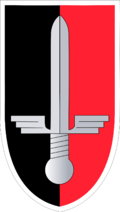
First Combat – World War II
Barkhorn flew his first combat sorties over Belgium and France during the Battle of France and later over southern England during the Battle of Britain, flying the Messerschmitt Bf 109E. On 1 August 1940 Barkhorn was transferred to 6/JG 52. He did not have any success, although he flew some 21 combat sorties and was shot down in the English Channel on 29 October by RAF fighters, but rescued. Shortly thereafter he was rewarded with the Iron Cross 1st Class. In the Squadron, he flew alongside another promising pilot, later an Air Ace, Hans-Joachim Marseille, “Star of Africa”.
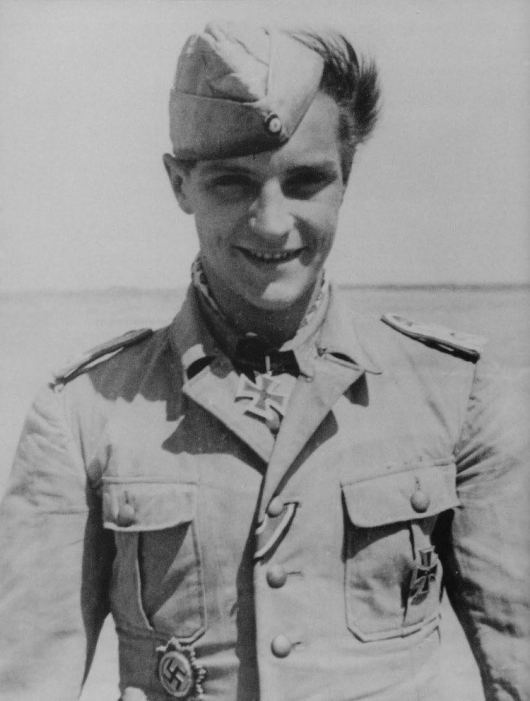
Moved to Eastern Front – Opens Air Victory Account
In 1941, JG 52 was transferred to the east and participated in Operation Barbarossa, the invasion of the Soviet Union, on 22 June 1941. Subsequently, Gerhard Barkhorn scored his first victory by shooting down a Red Air Force DB-3 bomber on 2 July, flying his 120th combat sortie. By November his tally had reached 10 victories and he was promoted to Lieutenant on 11 November 1941. On 21 May 1942 Barkhorn was appointed Squadron Commander of 4./JG 52.

Ace in a Day
He continued to add to his score over the next year, until on 19 July when he became “ace-in-a-day” by shooting down six aircraft in his Bf 109F. He was wounded on 25 July and put out of action for two months, returning to combat in October. During July 1942 alone, Barkhorn had destroyed 30 Soviet aircraft. On 23 August he received the Knight’s Cross of the Iron Cross for having shot down a total of 59 aircraft. After a two-month break from the front he returned to action in early October.
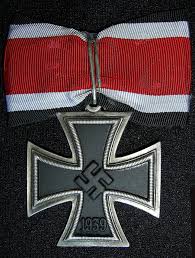
Crosses Century Mark
On 19 December 1942, Barkhorn had raised his score to 101 victories. That day, he became the 32nd Luftwaffe pilot to achieve the century mark. Barkhorn came to respect the Soviet pilots. On one occasion he was involved in a forty-minute dogfight with a Lavochkin-Gorbunov-Gudkov LaGG-3. “Sweat was pouring off me just as though I had stepped out of the shower,” he recalled: despite having a faster aircraft he was simply unable to get a bead on the Russian pilot.
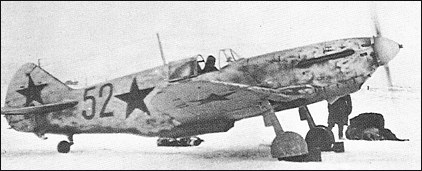
Shoots Hero of Soviet Union
On 9 January 1943, Barkhorn claimed his 105th. His victims included Lieutenant Vasiliyev, and Hero of the Soviet Union Podpolkovnik (Lt Col) Lev Shestakov of the 236 IAP Fighter Regiment. Barkhorn strafed their Yakovlev Yak-1 fighters until they caught fire. Both pilots survived. Barkhorn was awarded the Knight’s Cross of the Iron Cross with Oak Leaves on 11 January 1943.

First German to Cross 1,000 Missions
Barkhorn, now a Captain, was appointed Group Commander of II./JG 52 on 1 September 1943. On 5 September he shot down another Hero of the Soviet Union and Soviet fighter ace Nikolay Klepikov, an ace with 10 personal and 32 shared victories. This was offset by the loss of II./JG 52’s 173-victory German Ace Heinz Schmidt. The two Lavochkin La-5s shot down by Barkhorn were his 165th and 166th aerial victories. Barkhorn reached the 200 mark on 30 November 1943. On 23 January 1944 Barkhorn became the first German pilot to fly 1,000 combat missions.

Second German to Cross 250 Victories
The main German fighter unit covering the Crimea and Kuban was his II./JG 52 and in the three months between December 1943 and 13 February 1944 the unit claimed 350 victories, of which 50 were claimed by Barkhorn personally. Earlier he had claimed 15 victories in September, 23 in November and 28 in December, including seven on 28 December alone. On 13 February 1944 he reached 250 victories. Barkhorn was the second to reach this total.

Best Man For Fellow Ace Erich Hartmann’s Wedding
On 2 March 1944 he was awarded the Knight’s Cross of the Iron Cross with Oak Leaves and Swords He attended the wedding of fellow pilot Erich Hartmann as best man. Barkhorn was promoted to Major on 1 May 1944.
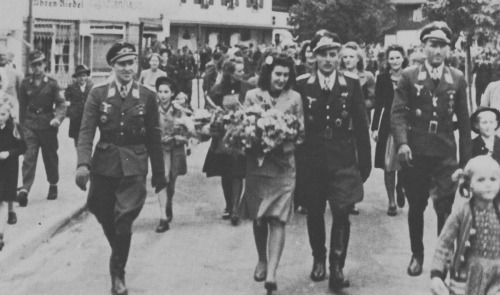
Hosptialised – Erich Hartmann Overtakes Total
On 31 May 1944, on 274 victories, Barkhorn was flying his sixth mission of the day and, being fatigued, was not concentrating on keeping a good look-out when he was bounced by a Russian Airacobra fighter and shot down in Bf 109 G-6 (W.Nr. 163 195) “Black 5”. He received severe wounds to his right arm and leg which put him out of action for four months as he was hospitalized. With Barkhorn sidelined, Hartmann was to overtake his total. Eventually returning to his unit the psychological damage and combat stress on Barkhorn became apparent; sitting in his cockpit he became overcome with anxiety, and even when flying with friendly aircraft behind him he felt intense fear. It took several weeks for him to overcome this condition. Returning to combat in October he claimed his 275th victory on 14 November. Over the next few weeks Barkhorn added another 26 victories, scoring his 301st (and final) victory on 5 January 1945.

Defense of the Reich – Eased From Command Due Health
On 16 January 1945 Barkhorn was made Wing Commander of JG 6 Fighter Wing, a unit assigned to defend the Reich and equipped with the Focke-Wulf Fw 190D. Barkhorn led this unit until the 10th April 1945. During this tenure he did not claim any aerial victories. JG 6 was a unit consisting mostly of new recruits and former Bf-110 pilots; it suffered heavy losses against the American air fleets. Barkhorn did not last long in this position and was forced to take a medical absence because of severe physical and mental strain and eventually relinquished command for another spell in hospital.
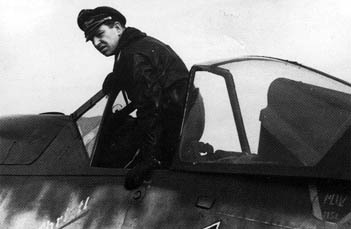
Moved To New Me-262 Jet Fighter – Last Missions
After his hospitalization Barkhorn was invited by Adolf Galland to join the elite JV 44 – 44th Fighter Detachment flying the Messerschmitt Me 262 jet-fighter. He found flying the Me 262 over the western front difficult and he did not score any victories in it. On 21 April 1945, he flew his 1,104th and last mission. One of the engines of his aircraft flamed out as he was approaching an enemy bomber formation and he was forced to make an emergency landing. As he approached the airfield, his jet was attacked by several prowling North American P-51 Mustang fighters. Barkhorn managed to land his burning plane though he received a slight wound as a result of this action when the cockpit canopy – which on the Me 262A, flipped open to starboard, like a Bf 109’s did – prior to crash landing, slammed shut on his neck. He was hospitalised. Barkhorn was one of the few noted Luftwaffe Experts who escaped being imprisoned by the Russians. However, he did become a prisoner of war of the Allies, finally being released by them in September 1945.
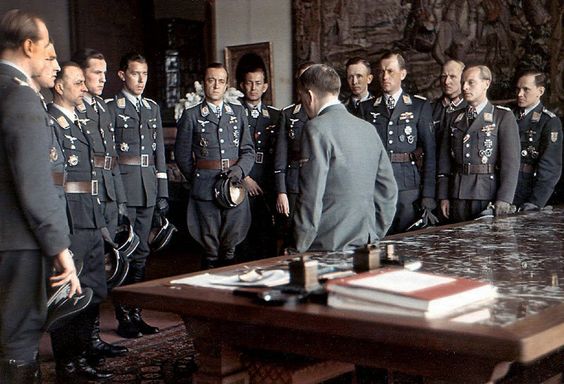
Initial Civil Life and Rejoins Service
After Barkhorn was released as a prisoner of war, he then found work in the automobile industry. Following the decision of the Cabinet of Germany to rearm the Federal Republic of Germany, Barkhorn joined the military service of the West German Air Force in 1956. From 1 April 1957 to 31 December 1962, he commanded the 31 Fighter-Bomber Wing.
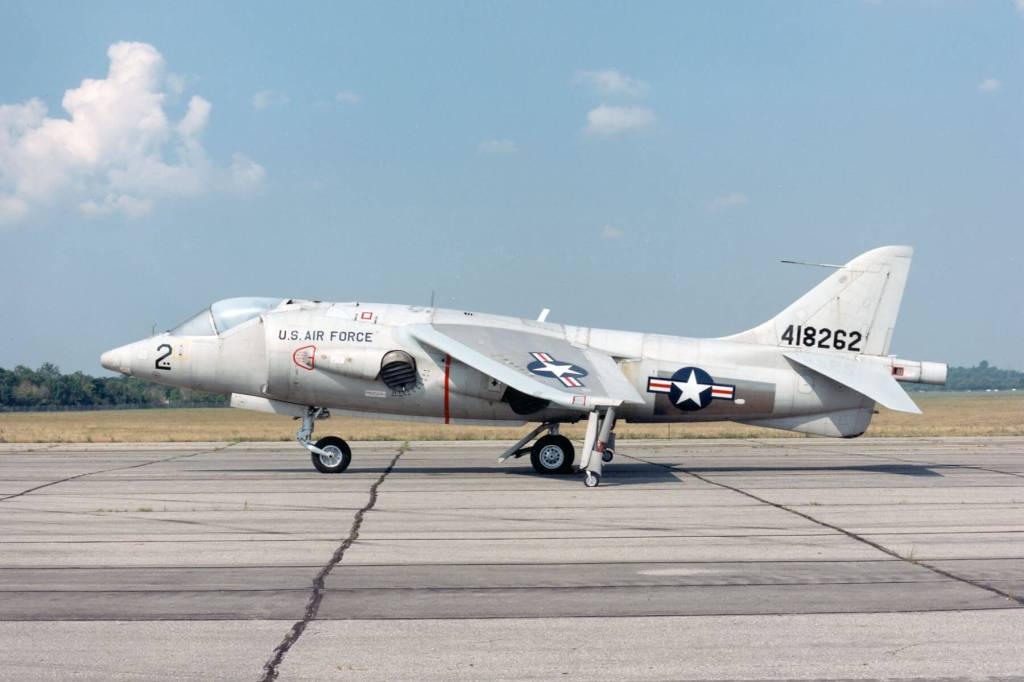
Flight Test Assignment
In 1964 he was posted to the staff of Air Force Test Command holding the rank of Colonel. From October 1964 until November 1965, Colonel Barkhorn headed the six-man West German Air Force contingent of the Tripartite Kestrel Evaluation Squadron at Royal Air Force Station West Raynham, Norfolk, England. The squadron’s mission was to evaluate the military capabilities of the VSTOL Kestrel, the Hawker Siddeley P1127 and forerunner of the Harrier VSTOL aircraft. The squadron consisted of military pilots and ground staff from three nations: Great Britain, USA and West Germany. In addition to being one of the squadron pilots, Barkhorn also served as one of the squadron’s two Deputy Commanders. At the conclusion of the evaluation, Barkhorn then accompanied the American contingent to the US, where he assisted in that nation’s continuing trials of six of the Kestrels that had been shipped to the US and renamed the XV-6A.
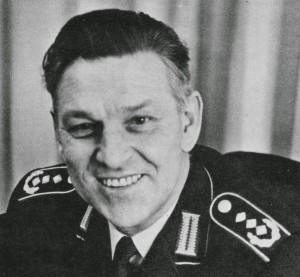
Higher Appointments
Barkhorn was promoted to Brigadier general in 1969 and to Lieutenant General in 1973. His last position was Chief of Staff of the Second Allied Tactical Air Force, a NATO military formation under Allied Air Forces Central Europe. He retired from active service on 30 September 1975.

Death in Car Accident
On 6 January 1983, during a winter storm on an autobahn near Cologne, Barkhorn and his wife, Christl, were involved in a serious automobile accident. His wife died instantly and Barkhorn, without regaining consciousness, died in hospital in Frechen/Cologne on 8 January 1983, at age 63. They were buried in Tegernsee, Bavaria.
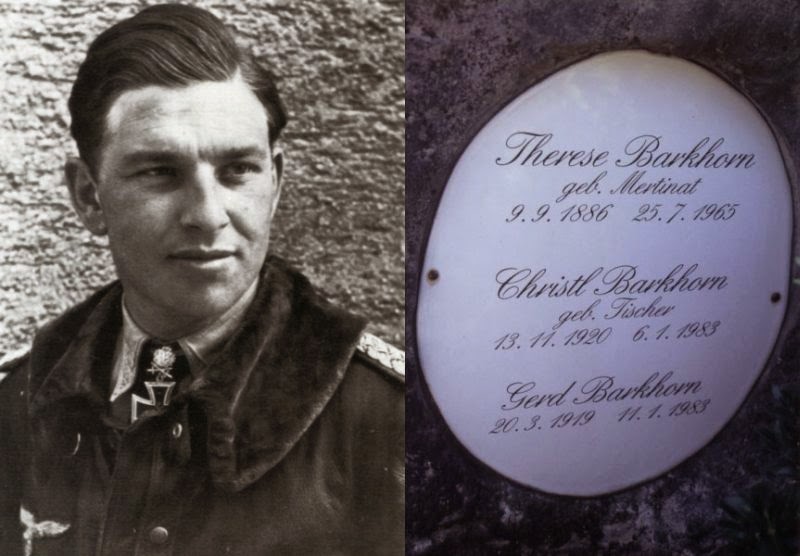
Summary of Operational Career
Barkhorn claimed 301 victories in 1,100 combat missions, mostly piloting Messerschmitt Bf 109 and Focke-Wulf Fw 190D-9 fighters. He flew in the famous Jagdgeschwader 52 (JG 52) fighter unit, along with companions aces, such as Hartmann and Günther Rall. He also served in the Jagdgeschwader 2 hunting wing.
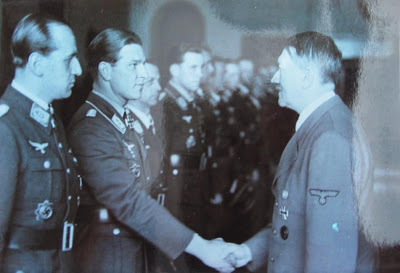
Barkhorn’s success had not come without some cost. He was shot down nine times, bailed out once and was wounded twice. Matthews and Foreman, authors of Luftwaffe Aces – Biographies and Victory Claims, researched the German Federal Archives and found records for 300 aerial victory claims, plus one further unconfirmed claim. Each claim is wwell documented with time and place. He was “Ace in a Day’ on five occasions, on 22 June 1942 (5 Victories), 19 July 1942 (6 Victories), 20 July 1942 (5 Victories), 02 December 1942 (6 Victories), 28 December 1943 (7 Victories). He shot down a very wide variety of aircraft including, Ilyushin DB-3, Polikarpov I-16, I-18 (MiG-1), Ilyushin Il-2, I-61 (MiG-3), Hurricane, I-153, P-40, R-5, Yak-1, LaGG-3, Pe-2, Spitfire, P-39, La-5, Yak-7, and Yak-9 aircraft.

Critical Milestones
- 5 January 1942 – his 30th victory
- 1 March 1942 – Squadron Commander of 4./JG 52
- 25 July 1942 – wounded while flying Bf 109 F-4 ‘White 5’
- 23 August 1942- awarded the Iron Cross, with 64 victories
- 19 December 1942 – his 100th victory
- 11 January 1943 – awarded the Oak Leaves, with 105 victories
- 8 August 1943 – his 150th victory
- 1 September 1943 – Group Commander of II./JG 52
- 30 November 1943 – his 200th victory
- 23 January 1944 – 1,000 combat missions (the first fighter pilot in history to do so)
- 13 February 1944 – his 250th victory
- 2 March1944 – awarded the Swords
- 5 January 1945 – his 301st, and last, victory

Honours and Awards
- Honorary Cup of the Luftwaffe on 20 July 1942
- German Cross in Gold on 21 August 1942
- Iron Cross (1939)
- 2nd class (23 October 1940)
- 1st class (3 December 1940)
- Knight’s Cross of the Iron Cross with Oak Leaves and Swords
- Knight’s Cross on 23 August 1942
- 175th Oak Leaves on 11 January 1943
- 52nd Swords on 2 March 1944
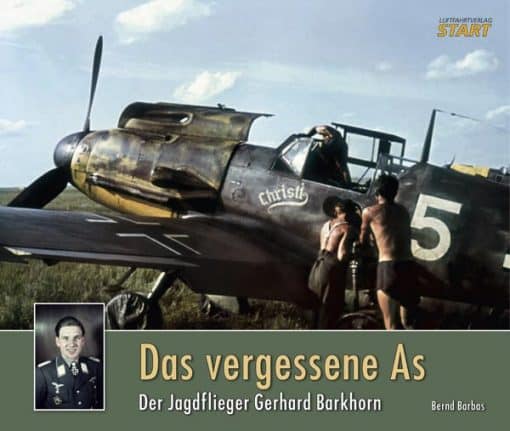
The Book – The Forgotten Ace: Fighter Pilot Gerhard Barkhorn
Despite Gerhard Barkhorn scoring the second highest 301 kills while flying with Jagdgeschwader 52 on the Eastern Front (making him the second most successful fighter pilot of the Second World War after Erich Hartmann) but today he is almost unknown. He was also not awarded the Diamonds to the swords and Oak leaves of his Iron Cross. Maybe he was not ardent enough a Nazi. This book describes Barkhorn’s wartime experiences with JG 2 on the Channel, JG 52, JG 6 and finally JV 44. Excerpts from original combat reports enable the reader to feel the drama of the events that happened back then. Published in this book for the first time are numerous colour slides taken by Barkhorn during his service with JG 52, as well as many black and white photos. It also contains colour profiles of every aircraft flown by Barkhorn. “The Forgotten Ace” is a book that examines all aspects of this fighter ace.
Image Credit: Pinterest


Great Story of a true ace who despite being shot twice, went on to be five times “Ace in a day”. I like thid concept of those days. Awesome narration of an even awesome pilot
LikeLiked by 1 person
Thank you Air Marshal. Happy that you enjoyed Reading
LikeLiked by 1 person
The picture of “Gerd” Barkhorn, “Bubi” Hartmann, “Mackey” Steinhoff, and Gunther Rall is historic. It must have been clicked sometime during the war. Little did they know then, that as time went by, between them, they had downed a piffling 1104 aircraft. They themselves had been shot down multiple numbers of times, escaped, injured, and hospitalized a countless number of times. They came back to Germany to receive their “Iron Crosses” and returned to fly and fight again and they did NOT go under the “wooden cross”. They all joined the post-war Luftwaffe and barring “Bubi” Hartmann, who left in a huff as a Colonel, they all made it to Generals. Some achievements in one lifetime. They sure were made of “Stern Stuff”. Was it DNA, upbringing, work culture, ethics, or little bits of all put together. Praiseworthy it is.
LikeLiked by 1 person
So well summarised. Great Pilots. Great Combatants. Great lives. Each and every aerial victory authenticated. Inspiration for future Air Warriors. Many have not had time to read about them.
LikeLiked by 2 people
Anil,
Another vintage stuff from you! Your ability to dig out such gems is amazing.
Thank you for an absorbing read. Looking out for more!!
LikeLiked by 2 people
Thank you Air Marshal Menon. We have so much to learn from Aviation History. My intention is to put these great stories together. Appreciate your encouragement.
LikeLiked by 1 person